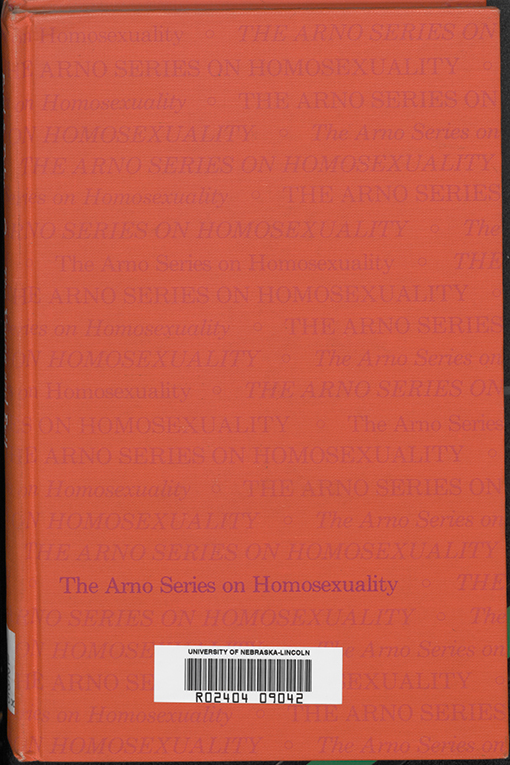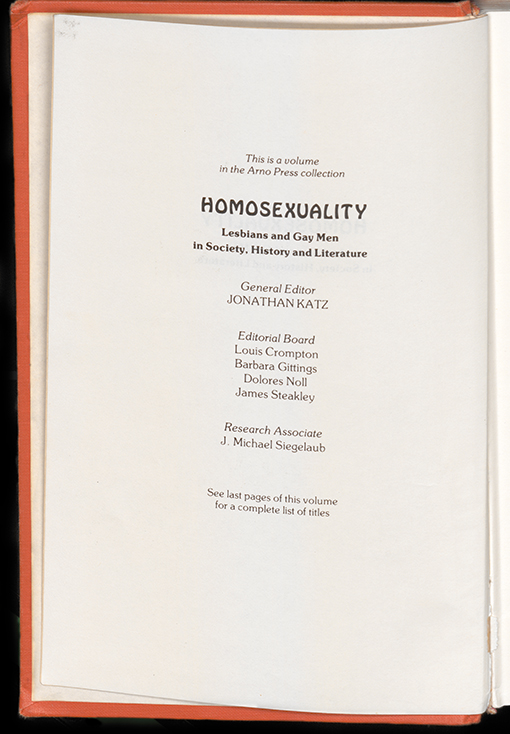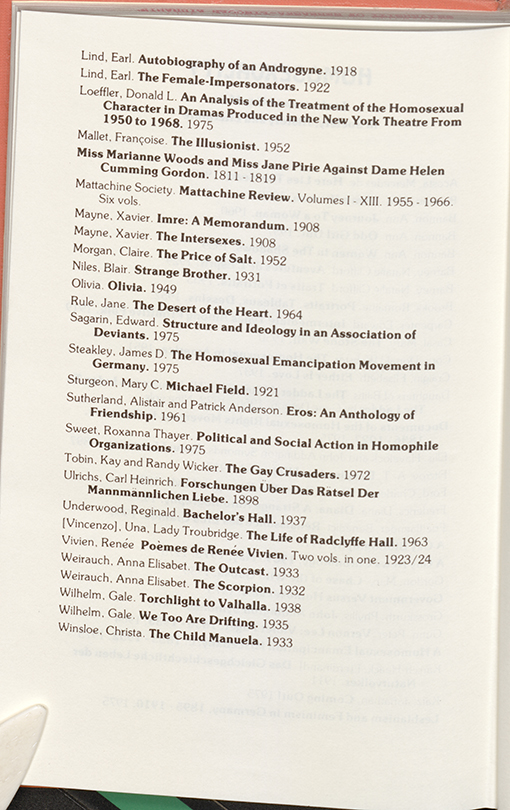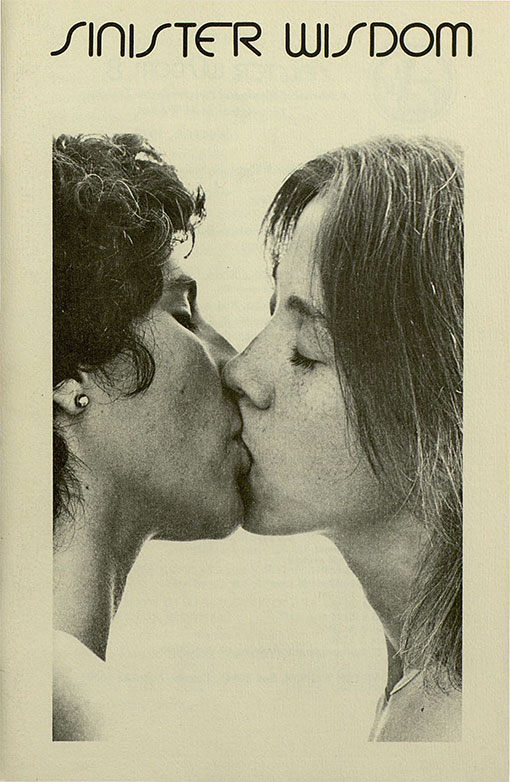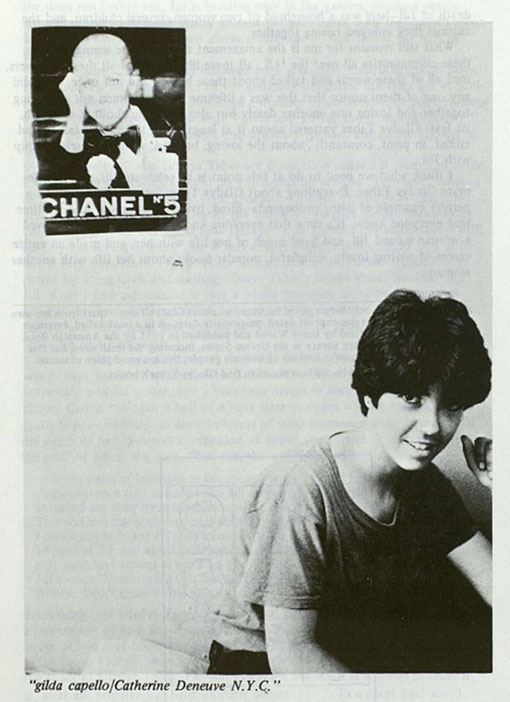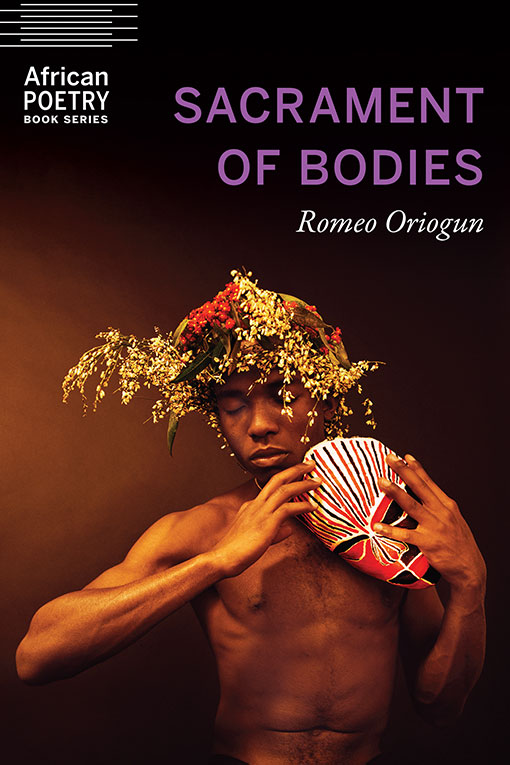Small Press History
Fire!!
“Aaron Douglas’ line drawings, so unlike his other work, charm us completely. His magnificent cover is the opening statement of FIRE!!’s themes: strength, sensitivity, and pride in heritage. One’s eye first sees the lion/sphinx – ancient Africa. Circles. Chains. Anger! Then, around the edges, the profile of a Black man appears. The circles are his earring. The abstract designs on the left are his eyes, nose, and lips. These features, which in the Twenties were frequently the subject of vicious racist caricature, coalesce into a new standard of beauty. The forms are elemental and strong, but not closed. So, too, is this young Black man – symbol of his people.”

Arno Press
UNL English professor Louis Crompton served on the editorial board of an Arno Press series called “Homosexuality: Lesbians and Gay Men in Society, History, and Literature.” In 1975, the series published more than fifty titles: some were reissues of classics of LGBTQ+ literature, while others were new books of research by contemporary scholars. The series also reprinted, in multi-volume sets, complete collections of early queer periodicals: The Ladder, which was the official publication of the Daughters of Bilitis, the first lesbian rights group in the US; and Mattachine Review, the publication of the Mattachine Society, an early US gay rights organization.
Among the titles in the series:
Imre: A Memorandum, by Edward Prime-Stevenson; the Arno Press publication was the novel’s first reissue since it was privately printed in a limited edition in 1906. The book was unique for its sympathetic portrait of a gay couple.
The Price of Salt, by Claire Morgan, a pseudonym for bestselling novelist Patricia Highsmith. First released in 1952, the Arno Press reprint in 1975 still published it under the author’s pseudonym; it wouldn’t be until the novel’s reissue in 1990, under the new title Carol, that the portrait of a lesbian love affair would be published under Highsmith’s name.
The Female-Impersonators, an autobiography by Earl Lind, first published in 1922, and a pioneering work in transgender literature. Arno also reissued Lind’s Autobiography of an Androgyne.
Miss Marianne Woods and Miss Jane Pirie Against Dame Helen Cumming Gordon, a collection of documents related to accusations of lesbianism against the headmistresses of a girls’ school in the early nineteenth century. The case was the inspiration for the Lillian Hellman play The Children’s Hour.
The first publication of contemporary dissertations included: An analysis of the treatment of the homosexual character in dramas produced in the New York Theatre from 1950 to 1968, by Donald L. Loeffler, and Political and Social Action in Homophile Organizations, by Roxana Thayer Sweet.
Sinister Wisdom
Started in 1976, Sinister Wisdom is the longest operating lesbian journal in history – after its fifth issue, it was invited to move to Lincoln, “by a group of wymyn there,” according to an editorial note. UNL English professor Julia Penelope joined the staff of the journal, which had the subheading of “A Journal of Words and Pictures for the Lesbian Imagination in All Women,” and it published issues 7-14 in Lincoln, before moving to Amherst in 1980. The cover here is from issue # 8, published in the winter of 1979.
Penelope served as the guest editor for issue #15, a special issue devoted to the topic of violence, to which she contributed the article “Mystery and Monster: The Lesbian in Heterosexual Fantasies.” The issue included poetry by Adrienne Rich, Paula Gunn Allen, Martha Courtot, and Anita Skeen, among others, as well as essays such as “The Lesbian in Pornography: A Tribute to Male Power” by Andrea Dworkin. The issue also includes the photographs of Emily Levine, a former student and staff member of UNL, who still lives in Lincoln. Levine also contributed photographs to issue #14, and posed for the cover. Levine’s “gilda capello/Catherine Deneuve N.Y.C.” is included above [right].
Scrip
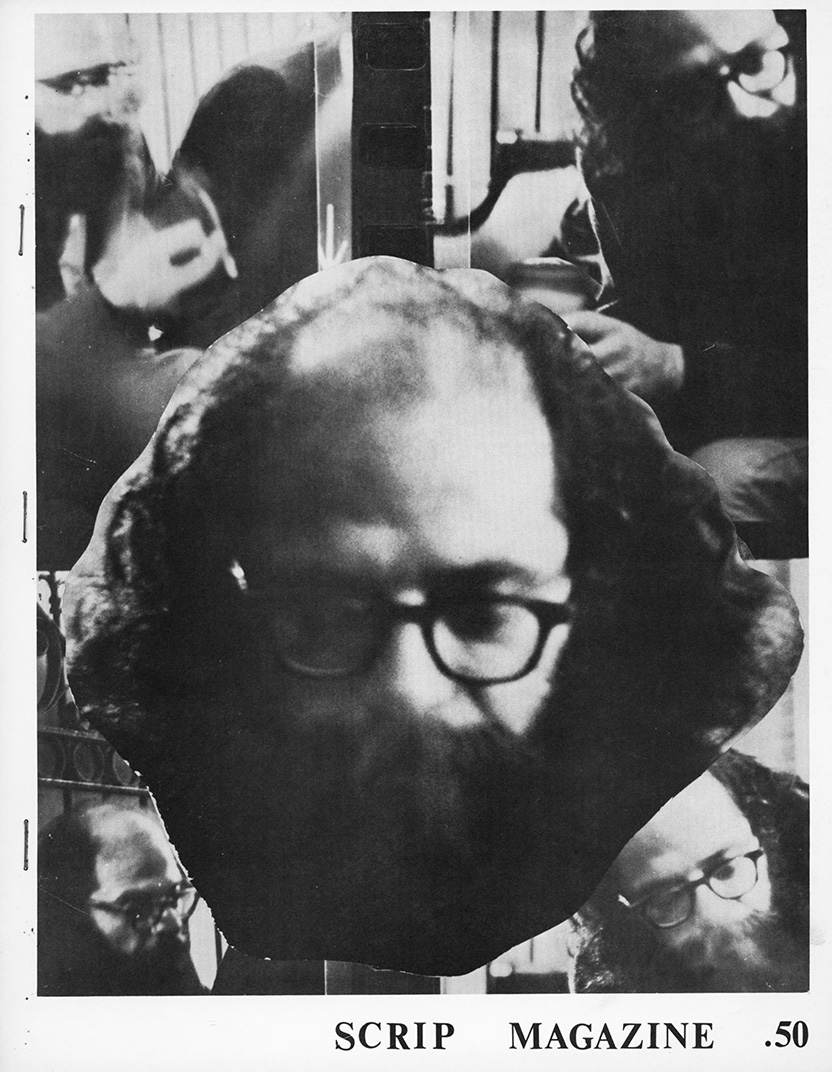
In 1966, Scrip, a student-run literary journal in the English Department of the University of Nebraska, had the opportunity to publish an original poem by the countercultural poet Allen Ginsberg. Ginsberg, who at that point was already a controversial figure (his poem Howl, a classic of queer literature, faced obscenity charges in 1956), was invited to campus by a group of student activists. For the occasion, Ginsberg wrote for Scrip a new poem titled “Auto Poesy to Nebraska,” which included references to Lincoln and Omaha, and ended with a reference to O Street (re-dubbed “Zero Street” by Ginsberg). All the student work in the special issue of Scrip was specifically inspired by Ginsberg, and the cover featured a collage of photos of the poet by Steve Abbott, the magazine’s student editor. Abbott himself would later become a poet and journalist in the queer literary scene of San Francisco.
Abbott announced his intentions to publish Ginsberg’s poem in a letter to the Daily Nebraskan, the campus newspaper. But the magazine’s faculty advisor, Robert Narveson, followed up with a letter of his own, indicating that because Scrip was a forum for student writing only, the Ginsberg poem wouldn’t appear. Narveson wrote, “Scrip must shine, however dimly, with such illumination as student talent can provide, and not with borrowed light from mature and established talent.” (Narveson was otherwise supportive of the poem, and of Ginsberg’s campus visit.) The editors of Scrip didn’t allow this restriction to interfere with their publication of “Auto Poesy to Nebraska,” even as they abided by the professor’s demands. They simply mimeographed the Ginsberg poem (which ran four pages), stapled it, and slipped it between the covers of every issue of Scrip sold.
During Ginsberg’s visit to campus, he gave interviews, visited classrooms, and made a few public appearances, during which he spoke out against the Vietnam War, spoke in favor of the legalization of marijuana, and discussed homosexuality. (Ginsberg was traveling the country with his longtime partner Peter Orlovsky, in a Volkswagen camper Ginsberg bought with money from his Guggenheim fellowship.) In a Daily Nebraskan article about a press conference held in Abbott’s apartment, reporter Kelley Baker quotes Ginsberg as saying, “Primarily I’m homosexually oriented, but I don’t make any bones about it in public.” He went on to say that people should “stop being critical about basic desires and should stop being afraid of being themselves in public.”
A Daily Nebraskan article from Feb 21, 1966, notes that 1,000 students were in attendance at Ginsberg’s reading in the ballroom of the Union. He read “Auto Poesy to Nebraska,” among other poems.
“Students perched on the windowsills,” wrote reporter Julie Morris, “leaned over the railings of the balcony, stood in the back of the room, camped on the floor in front of the stage and crowded into the hallways to hear Ginsberg. Some left at times during the two-hour session, but the room remained crowded and smoke-filled for the greater part of the program.”
Ginsberg’s visit inspired much discussion in the days following, with several letters to the editor published in the Daily Nebraskan. A letter credited only to “A Law Student” criticized Ginsberg and the university for hosting him. “Via a lewd description of the worst possible degree of human degeneracy, Mr. Ginsberg filled the hearts of hundreds with disgust and embarrassment,” the student wrote. This led to multiple responses in defense of Ginsberg’s visit, without necessarily supporting Ginsberg’s perspectives and way of life.
Steve Abbott would go on to become a notable writer in the San Francisco literary scene of the 1970s and 80s; he’s also the subject of his daughter Alysia Abbott’s memoir, Fairyland, which is in development as a film by Sofia Coppola, director of The Virgin Suicides. Beautiful Aliens: A Steve Abbott Reader was published last year by Nightboat Books.
Abbot was an editor, critic, and journalist, while also publishing his own fiction and comics, sometimes as pamphlets, which were then sold in the bookstores and record stores of the city’s gay neighborhoods. He organized readings featuring the city’s queer authors, and he edited small literary magazines that published these authors. He also raised his daughter alone, following the death of his wife in 1973. He identified both as bisexual and gay throughout those years in San Francisco. He died in 1992 from complications from AIDS
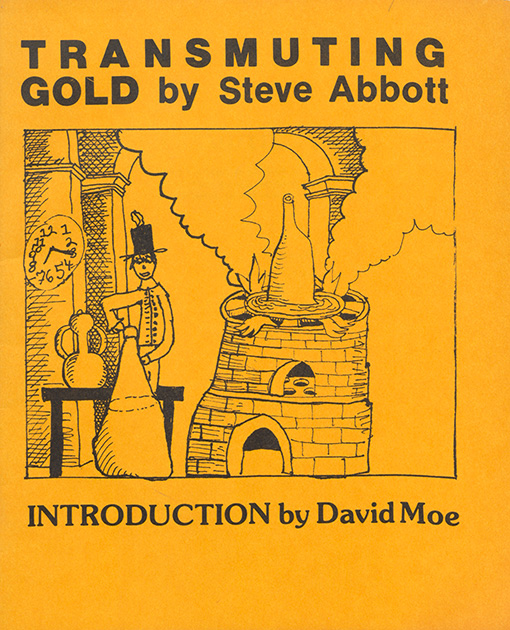
Transmuting Gold by Steve Abbott from Archives & Special Collections
In San Francisco in the 1970s, Abbott began developing what would become “a signature of his creative work, the poetry cartoon,” according to Jamie Townsend, editor of Beautiful Aliens: A Steve Abbott Reader. “Inspired by comic maverick and friend, S. Clay Wilson [also from Lincoln], as well as the countercultural irreverence of Zap, Steve took full advantage of the zany humor, anti-establishment politics, and soft surrealism of popular underground comics when illustrating versions of his poetry and queer hippie narratives.”
Prairie Schooner & African Poetry Book Fund
Prairie Schooner, UNL English’s international literary journal, has published since 1926, and it has contributed in significant ways to LGBTQ literature under the editorships of Hilda Raz (who served from 1987-2010) and Kwame Dawes (2011-present). Raz herself published a collection of poems, Trans, and What Becomes You, a memoir written with her trans son, Aaron Raz Link. Some queer authors did contribute to the journal in its earlier days, including Oliver Evans, who was a professor of English, a poet, and longtime friend and lover of Tennessee Williams (who himself contributed to the journal).
The journal’s founder, Lowry Wimberley, cited his colleague, queer author and creative writing professor Melvin Van den Bark (profiled in this web exhibit), as inspiration for the creation of the journal and its initial commitment to literature of the Midwest. In the first issue of Prairie Schooner, Wimberley published a story by Mari Sandoz, a student of Van den Bark’s who herself noted Van den Bark as a singular influence on her work; other of Van den Bark’s students also published in the journal, and worked as editors.
Queer contributors to the journal have included Jane Barnes, Robin Becker, Beth Brant, Truman Capote, Natalie Diaz, Roxane Gay, Rigoberto González, Lori Ostlund, Constance Merritt, Eileen Myles, D.A. Powell, Minnie Bruce Pratt, Aleida Rodríguez, Kevin Simmonds, Danez Smith, and Bradford Tice, among many others. The Prairie Schooner Book Prize has contributed to the body of LGBTQ+ literature, with books such as Call Me Ahab by Anne Finger.
With the African Poetry Book Series, Dawes has continued this tradition of LGBTQ literature with, among others, Sacrament of Bodies by Romeo Oriogun, a Lambda Literary Awards finalist. Dawes writes in the introduction to New-Generation African Poets (Saba), a chapbook collection published as part of the African Poetry Book Fund: “In poem after poem in this box set, the body figures (as it has in much poetry from Africa over the last few years) as the subject of rich study to any enterprising scholar who is interested in discovering intersections between sexuality, gender, alienation, and self-image and identity in African writing.”
Zero Street
Zero Street Fiction invites submissions of novels and short story collections, from LGBTQ+ authors new and established, that feature LGBTQ+ characters and/or themes. The series is particularly interested in BIPOC authors, trans authors, and queer authors over 50. Zero Street is committed to literary fiction with commercial potential, and to providing marginalized authors opportunities for a wide readership in the trade fiction market. We are seeking literary fiction of all kinds, from stories of modern life to innovations on traditions of genre.


